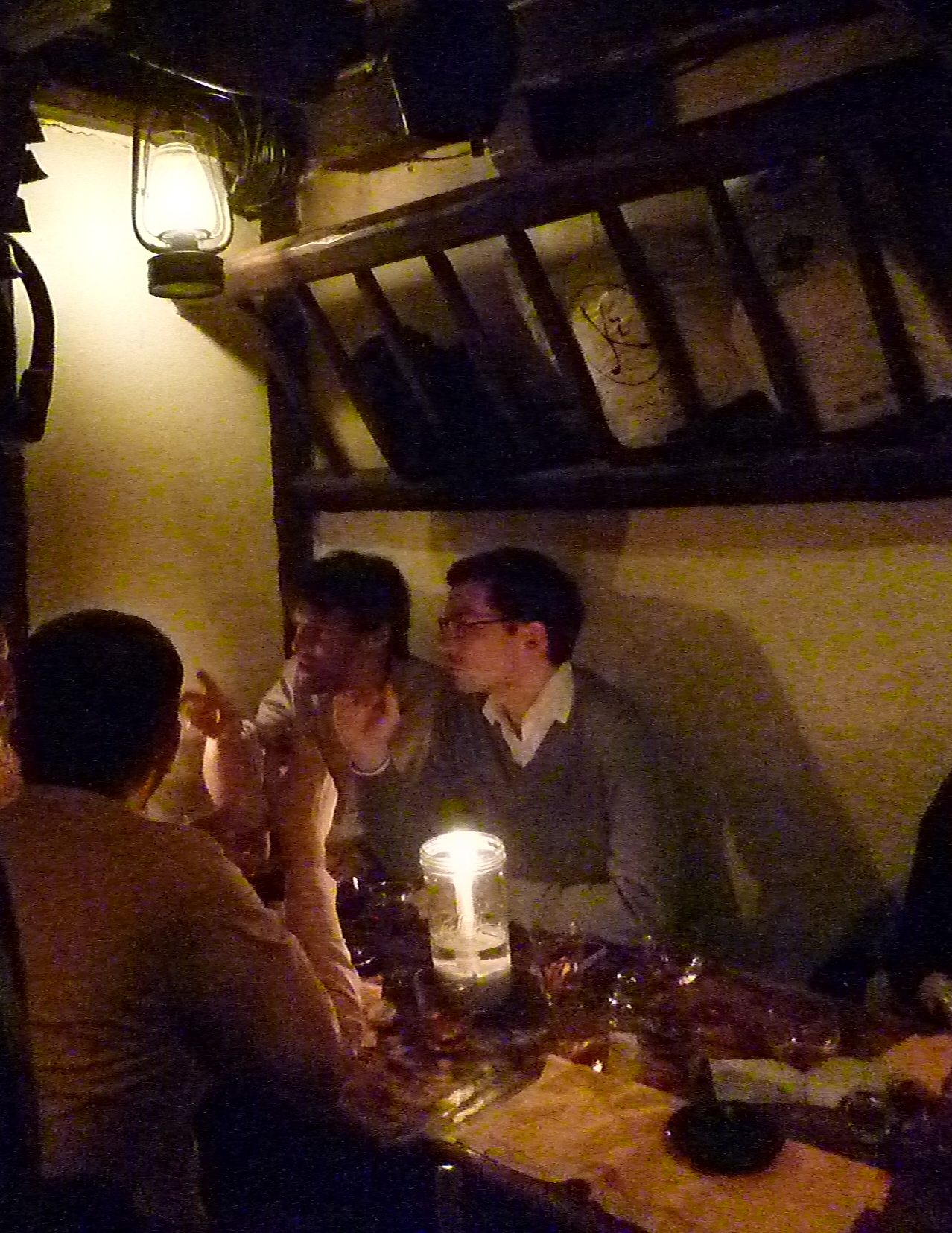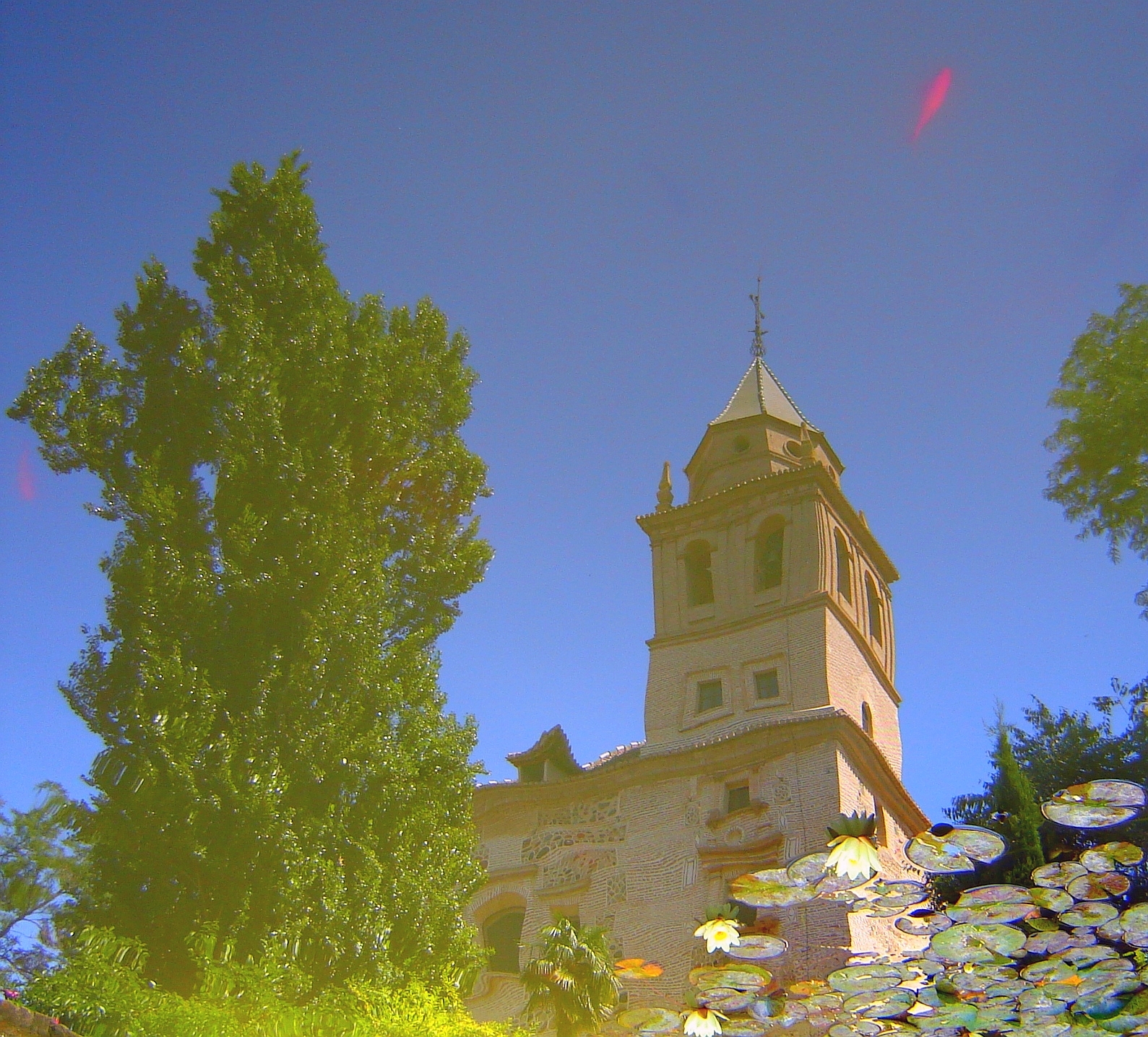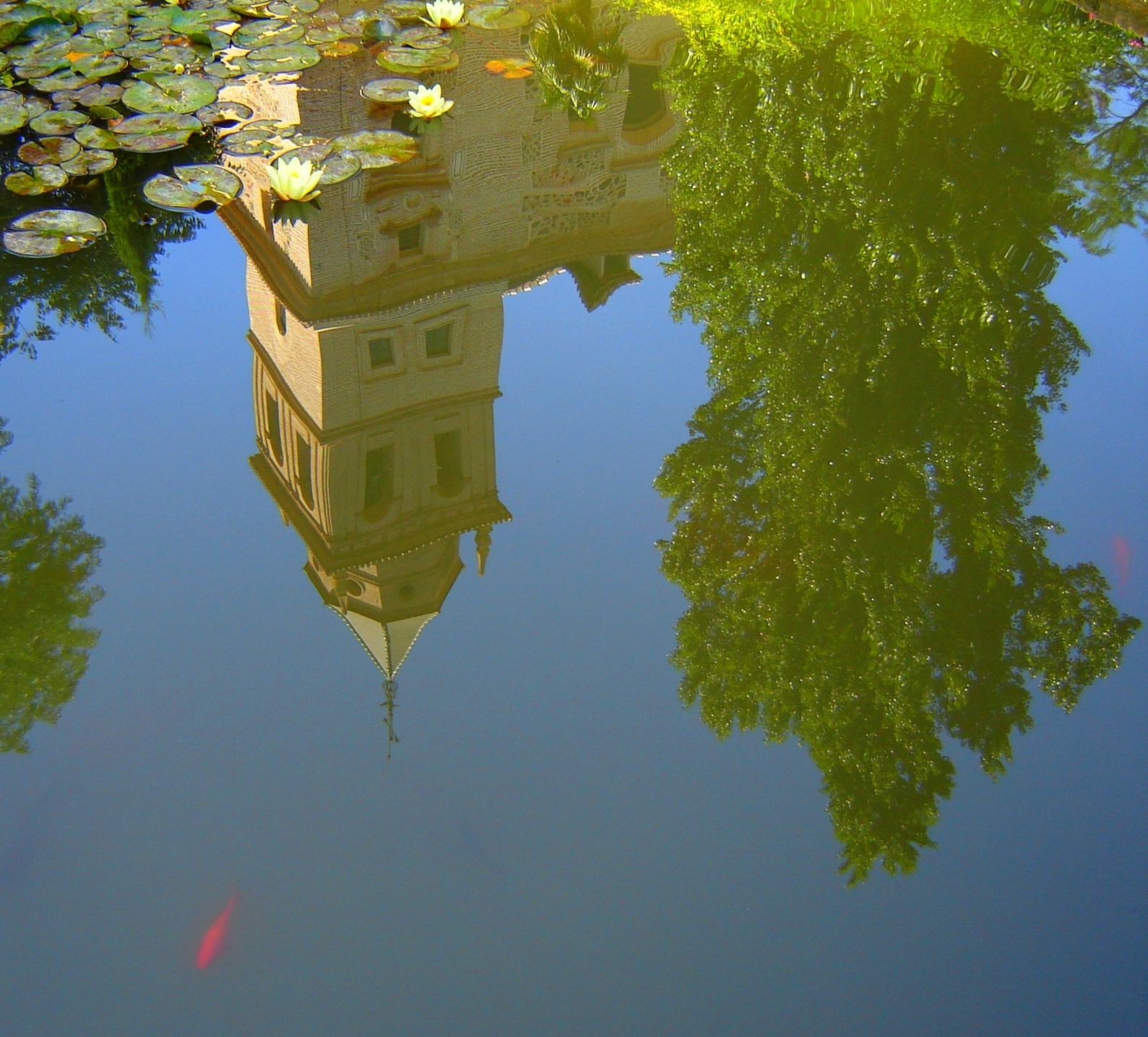

It looks like an old Dutch painting, but it's a photo of L'Ecurie: a dim-lit, ancient restaurant in what once was a stable. Lisa and I are back in Paris — and every time we come here, we eat at L'Ecurie.
See that wooden rack? That's bread up there. The food is reliably good, and the woman Miny who owns the place is tremendously sweet when Lisa said how much we like coming back here, she gave Lisa a kiss on the head!
This review by Brian C. gives some of the flavor:
In the Place de la Montagne St Genevieve very near the Pantheon. A most extraordinary place. The decor has not changed possibly for a hundred years. The bar counter is still a 'zinc'. When you arrive the manager plonks down a sangria in front of you 'on the house'. The menu is small but the quantity is immense. A lot of 'chips' and different bits of beef. Wine comes in carafes. One could say an atmospheric place. No decent woman would attempt the toilet . Nor would few men. I have never seen, even in la France Profonde, a more primitive structure. Even the owner advises people to go across the road to another establishment "if you cannot face the toilet". She has an arrangement! Her sons tell her she should upgrade the whole place but it would most certainly lose character! That would be a pity. But you would think that the toilet could be modernised.But this tale from the book Through Darkest Gaul with Trencher and Tastevin is even better:
I went on a sunny evening (one of the few this sodden summer) and found an ancient seedy building whose decor, inside and out, could best be described as Dickensian Hippie. The facade was the sort of black which might have begun decades ago as any other color, with decoration which included a couple of brightly-painted cartoons and an amazing tattered photo of an ancient bearded gentleman on an enormous tricycle, a parodic Horseman of the Apocalypse. Over the sidewalk hung a sign with a stylized representation of a strutting Etruscan stud. The tables inside were crowded and higgledy-piggledy, so I opted for a small table on the sidewalk in the sun with the grill just the other side of an open window. There I could enjoy everyone else's dinner as well as my own.I was immediately brought a glass of sangria, a basket of bread, and a generous dish of aioli which must have kept the staff occupied all day crushing the garlic. The aroma wafting through the window told me that my first course had to be grilled marinated sweet peppers and tomatoes, brushed with the marinade and sprinkled with basil. These proved to be succulent even beyond expectation. For a main course I settled on grilled lamb chops and French fries and was rewarded with lamb which tasted simply of lamb and fries which tasted of potato. My only mistake was to pass up the house wine for an indifferent Provencal rosé. Subsequently I would adopt the maxim,
Don't stray
From the cliché,
Just stay
With the pichet!At the end of a leisurely meal I was brought a glass of calvados. (Like the sangria, it came with the territory.) By then the restaurant had filled up and a young couple with a baby, evidently friends of the staff, were regretfully informed that there was no room in the inn. Observing a star in the East, I stood up and offered them my table, which they gratefully accepted. Conversation revealed that he was himself a restaurateur, in charge of a riverside restaurant at the Bastille which was mentioned in one of my guide books. It was his night off. I was reassured; "Eat where the chefs eat," is my motto.
He proved to be very familiar with L.Ecurie and knew something of its history. The building itself, he thought, went back to the 16th century and the ground floor had been a restaurant for at least a hundred years. I would later discover that the bar inside was an original zinc. This was the metal from which they were usually made, so that it became the generic term even when the bar was wood or even plastic. Alas, this became common during the last war, when almost all of the zinc bars were melted down by the Germans. This is one of the few to survive, and the maker's seal is evidence that it dates from just after the Great War (as opposed to the others).
All this is still true. But it's just the start! For the whole story, go here:
Clearly this place inspires not just affection but love from many people. The reason, ultimately, is that Miny is more interested in making people happy than making money.

This is the category theorist Andrée Ehresmann in an anechoic chamber, computer in hand. Yesterday we went into this room at IRCAM, a famous experimental music laboratory in Paris.
An anechoic chamber is a room with walls designed to absorb all incident sounds — if you snap your fingers, it sounds strangely dead, and one of my hosts said you can lose your sense of orientation. At IRCAM they sometimes suspend a piano inside the anechoic chamber to study its sounds without any echoes getting in the way.
IRCAM is the Institut de Recherche et Coordination Acoustique/Musique. From the outside it looks unimpressive, because most of the rooms are underground. Inside they've got a huge performance space where all the walls are speakers... using computers they can make sounds move around the room. And I got a great demonstration of OMax, a program that can listen to musicians, learn the patterns, and start to improvise along with them in real time.
Andrée Ehresmann is a mathematician who began as analyst but then worked on category theory with her husband Charles, developing concepts such as double categories, internal categories and the like, often for the study of differential geometry. At IRCAM she is working on music theory with Moreno Andreatta and Alexandre Popoff.
They're studying 'K-nets', which are diagrams where the vertices are notes or chords, and the edges are musical operations like transposition (raising or lowering a note or chord) and inversion (flipping a note or chord upside down). K-nets were invented by a music theorist:
but they're easiest to define using some category theory. You start with a group G of musical operations (like the 24-element group of transpositions and inversions), think of it acting on a set S (like a set of notes or chords), and then look at a functor from a diagram D into G. Then the vertices of the diagram get labelled with notes or chords in S, while the edges get labelled with musical operations in G.
I had a great time, and hope to spend more time there someday when I return to Paris! Alas, I'm leaving the day after tomorrow.

The Alhambra is a marvelous palace in Granada, Spain. It started as a small fortress, but it was renovated in the 11th century by a Moorish king, and converted into a royal palace in 1333 by the Sultan of Granada. The Sultan's Canal carries water from a nearby river, and it goes by aqueduct the Alhambra. This was used for vegetable gardens and drinking water... but also fountains, ponds and a famous 'water stairway', which beautified and cooled the palace grounds.
The Alhambra is also famous for its gorgeous tiling patterns. Since I like the math of these, I photographed the Alhambra tiles when I visited Granada to give a talk at their Department of Algebra. (Yes, they have a department of algebra!) You can see some of my photos in "week267" of This Week's Finds, along with a discussion of the 17 "wallpaper groups" that show up as symmetries of tilings. John Conway has a cool way of proving that these 17 groups are the only options.
But yesterday, someone at Open University wanted a high-resolution copy of an Alhambra tile photo. In the process of giving it to them, I noticed that this picture of a pool isn't bad either. See the goldfish?

Lisa are getting ready to leave Erlangen and return to Riverside. Today I gave a talk at the computer science department here.
It turns out Erlangen is the 'sister city' of Riverside, California. When I first came here, I disovered this accidentally when I was registering at the town hall — I bumped into a little display in the town hall that announced this. But somehow an official from the local government found out I was giving my talk yesterday and wrote an article about it:
You can click to read a translation into English. It doesn't make much sense, but it's flattering.
Why are egg yolks yellow? They contain two very similar yellow chemicals called lutein and zeaxanthin. I like these molecules because one of them is perfectly symmetrical, and the other is almost perfectly symmetrical. Can you see which is which?
These chemicals are synthesized only by plants. They're called xanthophylls, from the Greek words for 'yellow' and 'leaf'. You can get lots of xanthophylls from green leafy vegetables like spinach. Plants use use xanthophylls to deal with problems that arise when it's too sunny. Bright sunlight makes a lot of triplet-state chlorophyll, an excited form of chlorophyll, which can cause chemical reactions that damage the plant. The xanthophyll cycle is a way of removing excess energy from triplet chlorophyll in a harmless way.
Animals get lutein and zeaxanthin from plants. The retina of your eye contains these chemicals! Since these chemicals look yellow, they absorb purple light... and it seems they help our eyes avoid the damaging effects of that light.
Why do egg yolks contain these chemicals? They're fat-soluble, so it's easy for them to get dissolved in the fatty yolk. But also, they seem to be important antioxidants during the rapid growth of an embryo, and help the embryo mount a good immune response to infections.
These chemicals are colorful because they have a long chain of conjugated double bonds between carbon atoms — shown as alternating single and double bonds in this picture. Electrons vibrate back and forth along this chain in a fun quantum way. So, when a photon of the right color hits the molecule, it can easily be absorbed — and its energy goes into the motion of electrons!
Like piano strings, electrons in chains of conjugated double bonds vibrate faster when these chains are shorter. Molecules with a chain of fewer than 8 such bonds absorb only ultraviolet light, so they look colorless to us. With every extra double bond, the system absorbs photons of longer wavelength. Lutein and zeaxanthin absorb purple light — so they look yellow. Carotene, from carrots, absorbs blue light — so it looks orange!
For more, see the great comments on my G+ post.
Grass is green because it contains chlorophyll. But why is chlorophyll green?
Chlorophyll contains chlorin, shown
here... and in the middle of the chlorin, a magnesium atom with 2
electrons missing! There are different kinds of chlorophyll
— but the most common have a long 'tail' of carbon and hydrogen
atoms, called phytol. For example, take
a look at chlorophyll
a:
The chlorin, with the magnesium ion in its heart, is the part that
absorbs light. It has lots of alternating single and double bonds,
and this so-called conjugated
system is really good at absorbing light.
What role does the magnesium ion play, exactly? I don't know! In my May 27th entry I showed you a xanthophyll, a
yellow-colored molecule that also absorbs light in the leaves of
plants — not for photosynthesis, but for dealing with situations
where there's too much light. Xanthophylls have a chain
rather than a ring of single and double bonds — and no
magnesium: just carbon, hydrogen and sometimes a couple oxygens at the
ends. But somehow magnesium is essential for the proper functioning
of chlorophyll: without it, plants get sick and die.
I like chlorin because it's almost but not quite symmetrical. At
first it looks as symmetrical as a square! But soon you notice that
two of the nitrogen atoms are attached to hydrogens and two are not.
Look harder, and you'll see even more asymmetries!
Three of the pentagons here have alternating single and double
bonds. They're called pyrrholes, and
electrons in these pentagons easily get excited by light. But the
fourth pentagon does not have alternating single and double bonds.
It's called a pyrroline, and
its electrons do not get easily excited.
You'll notice I never said why chlorophyll is green. One answer is
that it absorbs lots of light at the red and blue ends of the visible
spectrum, but not so much green. Here are the absorption spectra
of the two most common kinds of chlorophyll —
chlorophyll
a and
chlorophyll
b:
I bet physical chemistry is advanced enough now that we can show the
spectrum has to look like this, given the molecule structure of
chlorophyll and what we know about quantum mechanics. But there are
other ways to tackle the puzzle. For example:
Puzzle. Why aren't plants black, so they can absorb as much light as possible?
You can see a lot of discussion of this very hard puzzle on my Google+
post. In particular, this interesting paper:
seems to contain math errors, as discussed here and in some comments
on my G+ post:
For my June 2014 diary, go here.
© 2014 John Baez
baez@math.removethis.ucr.andthis.edu